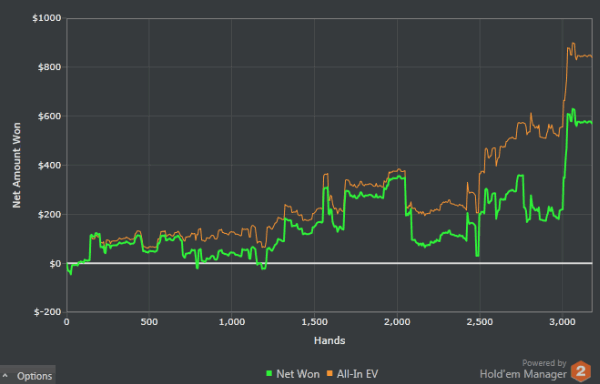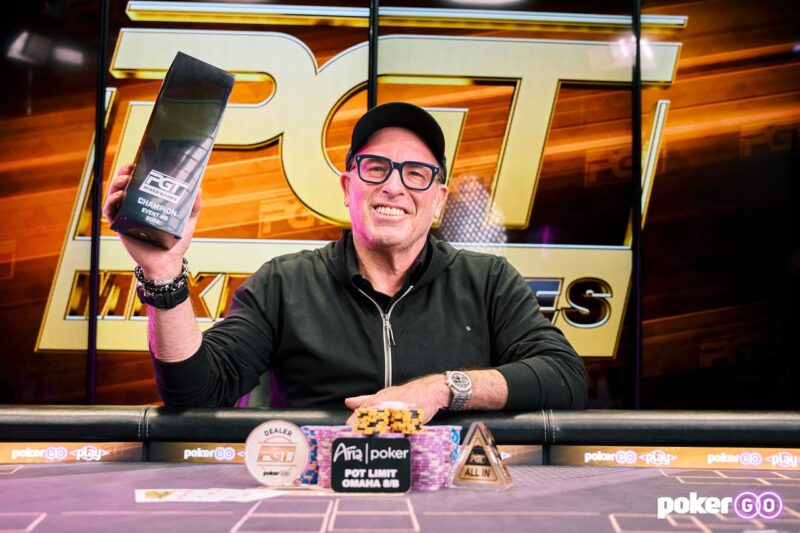There are some times in No-Limit Hold’em when you know you’re holding the stone-cold nuts and your only decision comes down to, how much money can you extract from your opponent on the river? It’s an enviable position to be in, to be sure, but knowing how much you can bet on the river to maximize your win isn’t always an easy question to answer.

Let’s say you were dealt A♦ K♦ under the gun in an eight-handed $1/$2 No-Limit game. You’ve been playing for about 30 minutes and have more than doubled your $300 buy-in to about $700 thanks to a hand against a maniac early in the session. He left after you busted him.
To keep this example simple, let’s say that you don’t know any of the players at the table, nor their proclivities; nor do they know yours.
Preflop
In this hand, you just call the big blind from your early position, as did two other players. The cutoff raised to $15, the big blind called, as did you and one other limper. Four of you see the flop 9♦ J♠ Q♦ and there’s $61 in the pot.
The flop
The flop is good for you; you hit the nut flush draw and pick up a gut-shot draw for the nut straight. The big blind checked and you bet $35. The next player folded, the preflop bettor called, and the big blind folded. You’re now heads up with $131 in the pot.
The turn
The turn is a complete blank – the 3♣. With two overcards to the board, the nut straight draw and the nut flush draw, you figure you have 18 outs to hit the best hand (figuring your opponent would have raised if he had two pair or trips), making you roughly a 3 to 2 underdog to hit the winning card on the river.
Assuming you have some fold equity, you semi-bluff $75 hoping for a fold, but with a back-up plan — expecting to improve to a winning hand nearly 40% of the time on the river. Your opponent, who has you covered with a stack of about $1,000, calls and there’s now $281 in the pot.
The river
The river is the beautiful 10♦, giving you both the nut straight and the nut flush and, possibly, making your opponent a good, but inferior hand as well. Your thoughts turn toward maximizing your certain win.
The Decision
Standard view
So, what do you bet here? From what I’ve seen, most reasonably good, rational players without a history with their opponent will typically bet something around half the pot in this situation. Their thinking is, generally, that they don’t want to bet too big, lest they scare their opponent into folding. Better, they reason, to keep the bet to half-pot, or even smaller, in an effort to entice a call.
An opposing view
While I understand the logic behind the standard play, I would argue that an over-bet — betting roughly double the pot by shoving your remaining $565 — is often the better play. (And, again, you would surely be affected by your knowledge of your opponents.)
Sure, your opponent might well decide that the bet is too much and fold, depriving you of the money you might have won if you had bet smaller. But I think there’s enough of a chance that he’ll call for the shove to be worthwhile. Let me explain why.
For one thing, your opponent might view your shove as an indication of weakness more than strength. From your opponent’s perspective, the shove is a polarized bet – either you have a monster or you’re bluffing. A smaller bet might well be seen as a value bet and be less likely to seem like a bluff. Ironically, by betting more, you may well be increasing the chances that your opponent will call with a semi-strong range like two pair, a set, or even top pair/top kicker as a bluff catcher.
There’s also something about a shove that signals desperation, especially to a seasoned player. The shove itself might trigger a call even more than a pot-sized bet.
But, you’re not basing your shove on the conclusion that your opponent is more likely to call it than they would a small bet. Even if you conclude that the shove is more likely to produce a fold than a smaller bet would, all other factors being equal, you’re still usually better off shoving than betting small.
Do the math
Players often err in this decision by failing to properly contrast the two options. They compare the likelihood that their opponent will call the two bets, but they fail to consider the relative reward each bet provides.
In this example, the call of the shove is worth considerably more than the call of the smaller bet. By shoving, you make the villain’s error of calling considerably greater than his error of calling a much smaller bet.
Let’s round off the numbers in this example to make the math simpler. Imagine your shove is $600 and your smaller value bet is $200. If that’s the case, you’ll win three times as much if the villain calls your shove as you would if he calls your small bet. Accordingly, if your opponent is likely to call your shove more than one-third as frequently as he would call the $200 bet, you should shove.
The amount you win with a shove will more than make up for being called somewhat less frequently than you would be by making the smaller bet.
Conclusion
When making a bet-sizing decision, it’s critical to consider all parts of the equation, including the risk and the reward. In this admittedly simplified example, the risk of your opponent making the correct fold when faced with your river bet must be viewed in the context of your potential reward if he errs and calls.
While your intuition may dictate that a small bet would likely suck him in, when properly considering all the factors in the decision — and the potentially outsized reward if he calls an over-bet — the correct play is almost always to make a very large bet.
All other things being equal, the bottom line is when you’re unsure of the relative effectiveness of a small bet vs. a large bet, go large.


